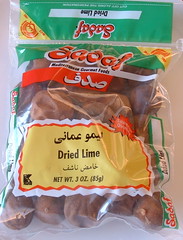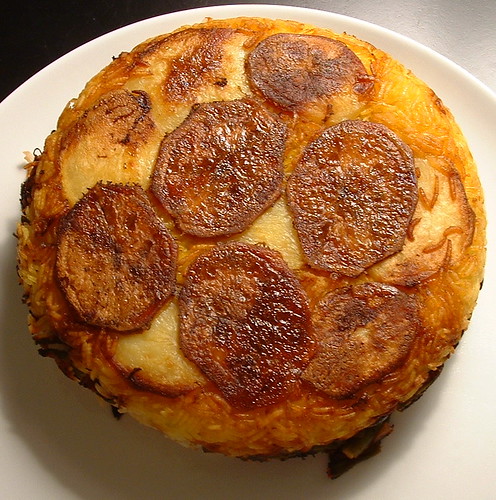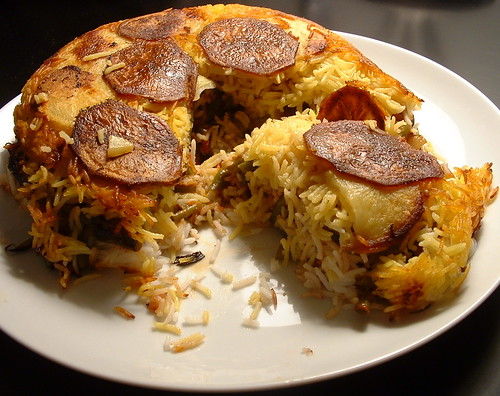For someone who is pretty much obsessed with cooking and eating, my cookbook collection is a fairly tiny one: about 20 cookbooks and a few booklets. All but one have been gifts from encouraging friends and family (the only one I actually bought is Dakshin). In a couple of cases, "gifts" is a euphemism for "stolen from my mother when she was not looking". I tend to use my cookbooks for two things: the glossy ones to moon over, and the others as sources of ideas and inspiration. To be perfectly honest, it is only in the last couple of months that I have had the time to read through my cookbooks and really start using them. And one book is turning out to be a perfect treasure, and perfectly indispensable: Madhur Jaffrey's World Vegetarian.
I first jotted down some recipes from World Vegetarian when I borrowed it from the public library a few years ago, and then, when my friend Anu gifted me a B&N gift card, I ran out and bought the book. Madhur Jaffrey has managed to collect hundreds of the most interesting home-style recipes from all around the world, and neatly divided them into sections such as beans and legumes, vegetables, grains and dairy. It hardly matters if you are a meat-eater or not- if you are looking to eat more grains, beans and vegetables (and really, we all should be), this book will provide you with endless (a) tips on buying, storing and preparing these foods, for instance, 5 methods for cooking eggplant, (b) ideas on using these ingredients. I find myself turning to World Vegetarian constantly to find creative uses for, say, the big bag of kidney beans in the pantry or the extra cauliflower in the vegetable crisper.
The recipe that I am about to make today from this book comes from Iran. It is called Shamsi Davis' Persian Pilaf with Lime and Green Beans, or Lubia Polo. I am a sucker for layered rice, and this pilaf sounds so good: You make a delicious curry of green beans with some dried Persian limes. Then, you layer thinly-sliced potatoes, rice, and the green beans and cook it together into one heavenly pilaf.
What really intrigues me were the dried Persian limes that add a tangy note to this dish. In Indian cooking, we use so many different ingredients to add that tang: tamarind, mango powder, kokum, and of course, fresh lemon and lime juice. But not dried limes as far as I know.
In Jaffrey's words "Persian dried limes are a world unto themselves. Once you have discovered them, you will wonder how you ever lived without them". I don't need much convincing. That was enough to make me buy a bag on my last trip to the International market (they are very cheap, by the way).
The dried limes look, um, unimpressive, to say the least. Exactly like limes that have been sitting around for too long and have dried-up and shriveled. In my kitchen, these would be hastily thrown into the trash, but the Persians seem to know something that I don't.
Here are the three stages in the extraction of lime-y goodness: The whole dried limes are hard, dry and hollow. I used a hammer to split each into half or thirds. The minute you do that, you can smell a deep lime aroma, that to me, smelled like the delicious Indian lime pickles, and to V, smelled like some dried berries used in South Indian cooking. Anyway, the insides look awful and smell delicious (you can see the halves in the picture). Then, use your fingers to scrape out the black dried stuff (bottom right of picture) and discard the seeds.
Collect the dried pulp from 2-3 limes in a bowl, then run it through a spice grinder to powder it. This is the lime powder that you need for this recipe. You could use fresh lime juice as a substitute.
Persian Lime-Green Bean Pilaf
(Lubia Polo)
(Lubia Polo)
(Adapted from Madhur Jaffrey's World Vegetarian, serves 3-4)
1. The Rice: Rinse 1 cup Basmati rice 3-4 times in cold water, then boil in 2 cups water (lightly salted) until *just short* of tender. Drain well and set aside. The rice will be cooked again, so it should remain undercooked at this point.
2. Vegetable filling: Wash 2 cups of green beans (also called French beans or haricots verts) and cut them into thirds or so. Heat 1 tbsp. oil in a skillet. Saute 1 small chopped onion until lightly browned. Add the beans and saute for a few minutes. Now add 1/3 cup tomato puree, salt to taste and 1 tsp. garam masala (Jaffrey's recipe calls for cinnamon). Simmer the beans until tender, by which time the mixture should be quite thick. Turn off the heat. Add 1 heaping tsp. powdered dried lime or 1 tbsp. fresh lime juice and set aside.
3. Layering: In a non-stick pan, melt 1 tbsp. butter. Stir in 1/2. tsp turmeric and 1 tbsp. water. Layer the bottom of the pan with thin slices of peeled potato. Now gently layer the potatoes with half the rice, then the entire bean mixture, then the rest of the rice.
4. Cooking: Cover the pan and leave on medium heat for 10 minutes, then lower the heat to lowest point. Place a dish towel on the pan, under the lid (to absorb condensation), being careful to fold the edges of the towel over the lid so that it cannot catch on fire. Cook on low heat for 20 minutes, then let it rest for 5-10 minutes. The idea is to allow the potatoes to cook and brown, and for the rice around the edges to become brown and crisp. The time given here worked well in my kitchen, but may change for a different-sized pot and a different stove. Invert gently onto a serving plate. A non-stick pan makes this easy. Cut into wedges and serve!
The Verdict: We loved it. This was one special meal. I don't think the pictures quite do justice to how pretty this dish looks. The combination of juicy, tangy beans, rice and browned potatoes is just delicious. This recipe is a must-try! I know I am going to play around with the dried limes and try and find more uses for them.
I just realized that I have posted an upside-down recipe twice in 10 days! At least this one is savory and quite different from the first. Meanwhile, green beans represent "G", and we shall meet again on Sunday for the G of Indian Vegetables.





those limes look so interesting. their flavour must intensify so much in the drying process.
ReplyDeletebeautiful recipe!
Nupur, this sounds delicious and looks just spectacular! A gorgeous centerpiece for a festive meal indeed :)
ReplyDeleteI will have to look for those limes around town. Thanks for sharing!
Dried limes might be a new item for my pantry -- I've never used them, but this recipe looks so interesting. I was cleaning out my cookbook collection the other day (far more than 20 cookbooks, I'm embarrassed to admit), and found an old book of Madhur Jaffrey's called Far Eastern Cookery. I'm having fun reading through it again.
ReplyDeleteThis looks so good. I am drooling all over my keyboard and its only 10 in the morning! *sigh* its going to be a long day. Can't wait to try this.
ReplyDeleteSwati
Hi Nupur, Wow! another knock-off dish from your blog.I never used dried Lime before..Will definately try it out. Btw, "Tuk" in my recipe means " medley or music of flowing water" ..
ReplyDeleteNow this really is an interesting looking dish. I can just smell all that lime aroma!
ReplyDeleteWow...that looks like a royal meal !! I have simply fallen in love with the simplicity of the recipe to create such a wonderful looking dish!! Even I am a sucker for layered rice preparations, I'm going to give this a try tonight :-) Will come back to let you know how it goes.
ReplyDeletewhat a fascinating recipe. i have to get that book. your rice dish looks beautiful.
ReplyDeleteAwesome!! Whoever thought dries lime had its use!! must try soon!!
ReplyDeleteThis is a unique and interesting dish! I do enjoy Madhur Jaffrey recipes as well, her recipes do hit the spot every single time.
ReplyDeleteOh WOW, Nupur... this is the most amazing looking/sounding recipe! I've just GOT to try it... just as soon as I get my hands on some dried limes! What a GORGEOUS photo (of the finished product)!
ReplyDeletePicture looks good. Too tired to read the entire recipe or cook!! So, Im sitting here feeling very jealous - jealous of you and your lucky husband, who Im sure gets to hog on this stuff! I wish there was a way to *email* food. I would love to receive some today.
ReplyDeleteI love it when someone comes up with an ingredient I haven't heard of for WHB, and you've done it! Since I love lime, tamarind, lemon, sumac, anything with that sour taste, I know I'd love these dried limes as an ingredient. Salt Lake only has one international market, but I'll definitely look for them. The pilaf looks amazing.
ReplyDeletehmmm @ the green limes. Now I am really trying to jog my memory about the green dried limes. I've seen them at home but can't remember what mom used them for. This is definitely from before I started out in the Kitchen. Mom is definitely not into experimental cooking so in her case it has to be something indian. I guess another long international call is called for.
ReplyDeleteThe pilaf looks absolutely divine.
I have to say, that looks fabulous! Lubia polo has always been one of my favorite dishes, and to this day I ask my mom to cook it for me when I visit her! Isn't Madhur Jaffrey the best?
ReplyDeleteOh, and I have very few cookbooks- something we have in common. I usually copy recipes from the library or even {whispers} the bookstore. I have the poor grad. student mindset!
P.S. I think the potatoes on the bottom would be even more delicious if you were to put saffron in the butter instead of turmeric. Same color, though!
ReplyDeleteYes, I was thinking saffron, too. That's what I use. I make Lubia Polo, but never used the dried limes. A must try.
DeleteI love rice and I love polos...so what's not to love about your delicious looking dish?
ReplyDeleteAnna, that is so true...the lime flavor was very concentrated, candy-like, almost.
ReplyDeleteHi Linda, I just made this for a regular weeknight meal...but will make it again this weekends when friends come over for dinner :) it sure will make the meal festive!
Lydia, I think that is one of her earliest books. World vegetarian is so unique in the way it brings together simple recipes from all over the world!
Swati, let me know if you get a chance to try it :)
Hey Pinki, "tuk" has such a pretty meaning!
Meeta, yes, the aroma of the browned rice and the lime was truly exotic!
Bee, from what I know of your cooking, you will end up loving the tasty and healthy ideas in this book. Totally worth finding.
Manasi, do try it...it is quite a special dish!
ReplyDeleteHey Monisha, I agree, Jaffrey's recipes can be really off-beat and fun. But they work!
Shammi, thanks :) The photo was taken in artificial light. I can't wait for summer when days will be longer and dinner-times pics can be taken in natural light.
Raingirl, thanks for stopping by.
Kalyn, I know you would love this! It would make a most interesting variation to our usual tangy ingredients. Let me know if you have trouble finding it...I'll ship you a packet from here (they are incredibly light, basically weightless).
Bilbo, would *love* to know traditional Indian recipes using these, so hurry up and pester your Ma :)
Hey Bazu, I think the frugal grad-student mind-set is permanently etched on my mind :) So this dish is quite authentic, eh? That is so cool that your Mom makes this!
I do agree, saffron would make the potatoes even more exotic, but I got to tell you, the turmeric makes it very pretty and saffron-ish at a fraction of the cost :)
Hi Nabeela, does "polo" mean rice or pilaf or something? That is something that was not really explained in the book. I just think the name "lubia polo" is cute :)
Hi Nupur -- regular weeknights with dinner-for-two can be festive occasions too, yes? ;) I really can't wait to try this. It looks even better on second glance!
ReplyDeleteMarvelous recipe indeed..Who would know that even this thing would add that difference!!
ReplyDeleteWill definately try this one, might just replaced the 'dried lemon' with 'fresh lemom juice'
It may taste very different, but for with my impending qualifying exam, I am probably not going to make a trip to International market:(
I like the flavors from your blog. Have introduced so many of my friends to this blog:)
Wow. I had no clue that the dried limes were used in cooking. Looking at the picture, I thought you made some upside down cake. Wonderful.
ReplyDeleteNupur, good description. I am still waiting for a gift card to a bookstore to get my copy of World Vegetarian:-)this is one of the books I borrow pretty much back to back from my public library, precisely for what you have pointed out: it has vegetarian recipes, and introduces exotic new foods. Keep up the good work.
ReplyDeleteLinda, so very true! I do treat every meal as a special time :) I hope you get a chance to try this dish. I was excited to try it but the results were even more delicious than I anticipated.
ReplyDeleteRays of sun, I am sure it will be very yummy even with regular lime juice. Good luck for your qualifying exam. I know what an ordeal that is, but I am very sure you will do well!
Suma, it does look like an upside-down cake, just a savoury one!
Sheela, drop some hints to family and friends and I am sure you will get this as a gift :) Totally worth owning!
Polo in Persia is very much like our Indian pulao....rice cooked with some sort of meat/vegetable.
ReplyDeleteI got to know various types of rice dishes from reading Seductions of Rice by Jeffrey Alford and Naomi Duguid. Do check this book at your local library...it's simply THE BEST book on rice and accompanying dishes(and authentic to boot).
P.S: Have you noticed how the spanish rice dish 'paella' sounds very similar to polo/pulao/pilaf? :)
Hi Nupur! You have a delicious blog! I have taken Jaffrey's book out of the library as well, but after reading your post and seeing your dish, maybe I should purchase it too. I'll be searching for those dried limes too--you've intrigued me!
ReplyDeleteI happened upon your blog by chance today, while serching the net for a biriyani recipe. And what a find this has been! Absolutely love this blog, being a keen food-addict, whose particular addiction is indian food.
ReplyDeleteHi Nupur, this combination looks delish, will definitely give it a try. BTW I've tried your biryani and it turned out pretty good. You have a lovely blog, keep it up.
ReplyDeleteHi Nupur - I've fallen behind on my blog reading and I see you've been posting all sorts of good looking food! This sounds fantastic and now you've got me very curious about dried limes. I don't recall ever having seen them before, but I'll be on the lookout now... I'd love to try this and may even resort to plain old lime juice if need be!
ReplyDeleteOh Nabeela, polo and pulao, makes so much sense now that you explain it! Yeah, it is incredible...the etymology of the various words for yummy rice dishes. I have to look for that book!
ReplyDeleteSusan, thanks for visiting :) Your blog is gorgeous!
Thank you foodie! My addiction is Indian food too :)
Richa, thanks for trying the biryani. This one is really worth trying!
Cathy, they are the most unlikely "gourmet" ingredient! We can make this together in April if you like :)
This looks great! I was given a cooking class as a gift and the one I took was Persian cooking. One of the dished she mad was much like this sans dried lime but with added dates. I'll have to look for the lime.
ReplyDeleteI have two of Madhur Jaffrey's books, different than this one. I also have 2 of Julie Sahni's (sp?) and love them all. thanks for sharing!
Tried the pulao this weekend, it was Delicious..I used green bean, snap peas & frozen green peas. I know I will be savouring this delight quiet often. Thanks Nupur.
ReplyDeleteNupur-I had copied this recipe from a library book some time ago, and have been rummaging around everywhere looking for it. I should have looked on the internet first! And yours is gorgeous! I am going to try it tonight or tomorrow- though using ordinary limes.
ReplyDeleteI'm going to try to get a hold of some dried ones soon, though. I adore limes in every variation, including lime leaves, and want to try these.
thank you.
Good lord! That's way too much work! Limu Amuni (dried limes) are amazing, but I grew up just puncturing them with a fork before throwing them into whatever stew I'm making.
ReplyDeleteThen again I like the bitterness mixed in the limey goodness...
I read the recipe in the book and thought it looked interesting but reading it on your blog is what pushed me into trying it. I loved it! Reminds me of vegetable biryani. Dried lemons are definitely an ingredient I'm glad I discovered. Thank you for posting the recipe.
ReplyDelete- Uma